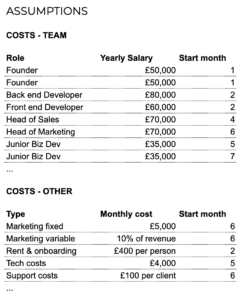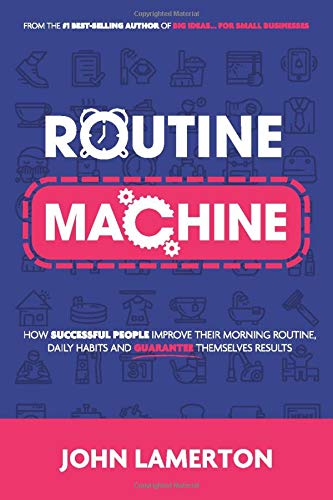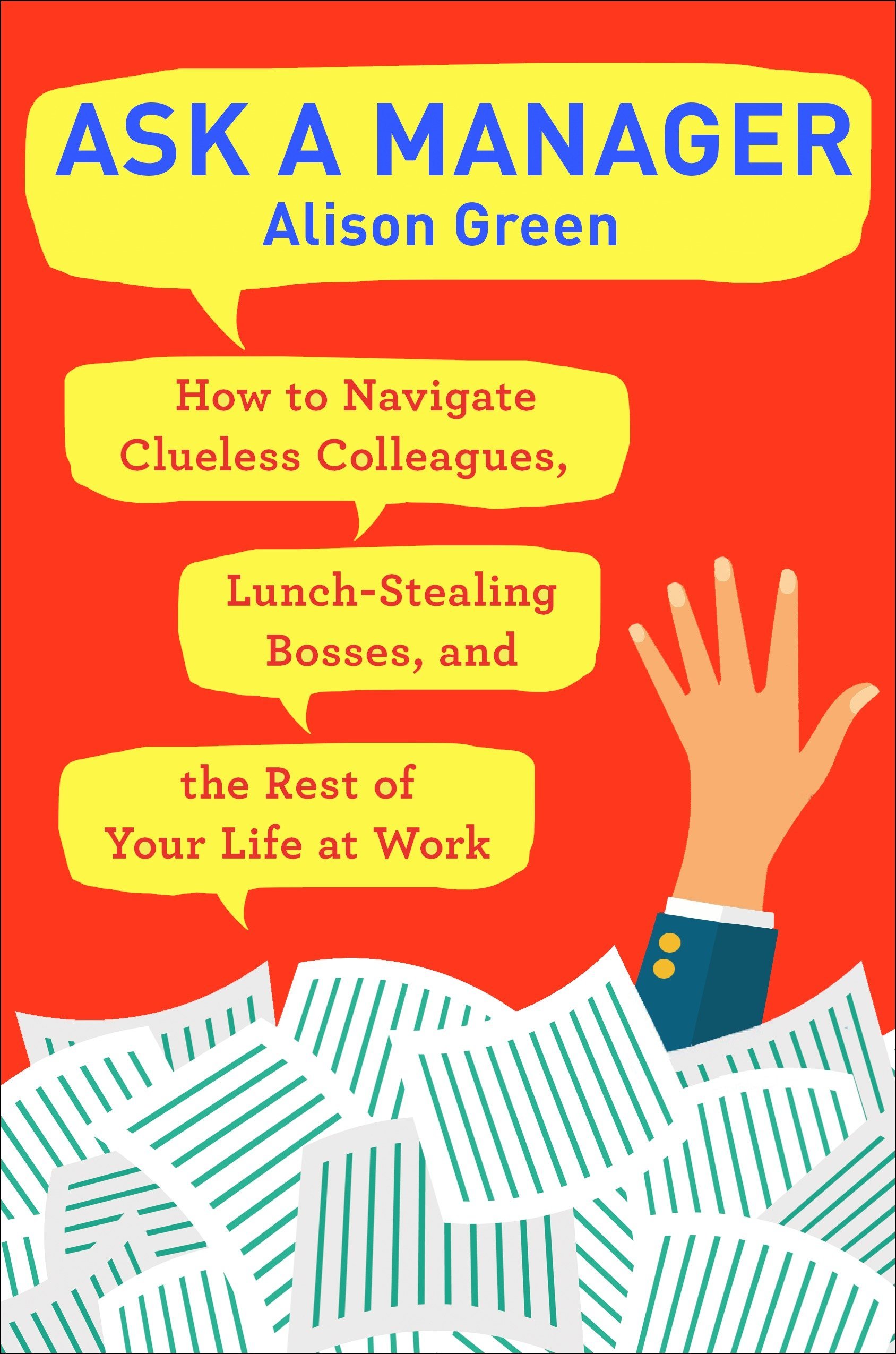The post How to budget as an early-stage startup appeared first on Beyond.
]]>Now is the time to show future investors they can trust you by building a beautiful budget – because naturally, you know what you’re doing!

Exciting possibilities lie before you – how are you going to allocate your funds? How much to hiring? Product? Marketing? Unlimited coffee?
This is where the trusty spreadsheet comes in… an inevitable recurring character for all startups.
1) Expense budgeting
For each cost, write down the amount and the month it starts. So if you’re hiring a software engineer, you’d write their annual salary and the month you plan to hire them. Once all your lines are written down, the magic of spreadsheets lets you automatically break this down into monthly costs.
2) Revenue budgeting
Do the same for your revenue plan. Divide it into different lines representing your income sources, factoring in all the stuff you tried to forget from school: customer acquisition costs, expected growth rate per channel, recurring versus one-off revenue etc. Add in any one-off cash injections like the money you managed to convince your elderly neighbour to ‘invest’.
Tips and tricks
When building expense and revenue budgets, you can make things more complicated (and thus more impressive!) by using drivers, formulas and percentages.
For example, you might want your marketing to scale with a percentage of your revenue, your support and infrastructure costs to scale with your number of clients, or your rent and onboarding costs to scale with number of employees.
3) Bringing it all together
One handy way to do this is to use multiple spreadsheet tabs with your different assumptions, and a tab putting everything together within a monthly view. Here you want a line subtracting your expense from your revenue (this is your profit/ loss), and a line that adds up this line cumulatively to get your ending balance.

Now you can work out some key budgeting stats:
- Runway: the month before all goes to shit and you run out of money.
- Cashflow positive: the month when you can organise a massive party because YOU’RE MAKING A PROFIT!!!
From this you can decide if you need to tweak your budget (eg decrease expenses), when to budget more expenses (eg new hires), when to raise a round (once you’ve proved scalability but far in advance of your max runway month), and when to despair.
Tracking your budget (rather than let it rot in your Google Drive)
As founder of an early-stage startup, you get the amazing privilege of coming in every month or so and course-correcting assumptions: increasing expenses when your junior BizDev accidentally miss-types an extra 0 in their ad campaign cost, or increasing revenue projections after managing to convince a client to sign up for the “Ultra-Premium” package.
A good practice here is to copy your budget before you adjust it, so you can keep track of how terrible your predictions are over time. You can get expenditure and revenue data from your accounting system or, because there’s few actuals at this stage, directly from your bank.
Crucially this is a chance to adjust your strategy as you go, rather than blindly charge into a wall. If you’re making a lot less revenue than expected, you might want to delay expenditure. If you’re making more, you want to accelerate instead. If your runway date starts to loom closer and your revenue is nowhere near your predictions, it’s time to re-evaluate your (company’s) life.

Good luck, and happy budgeting!
About me:
I’m the founder of Beyond, providing budgeting software for fast-moving SMEs. Beyond automates the day-to-day, so budget holders and finance teams can spot risk and confidently plan for the future.
The post How to budget as an early-stage startup appeared first on Beyond.
]]>The post 5 books to help you be more productive at work appeared first on Beyond.
]]>But knowing how to get the most out of that time can be tricky. We’ve all heard we should be working smarter, not harder – but no one ever explains how!
Thankfully, these 5 authors have put together actionable, accessible advice for all us Solanges on how to increase our productivity, focus on meaningful work, and get more efficient at the office.
Routine Machine, John Lamerton
As a British businessman, John Lamerton may not be the household name that Richard Branson and Alan Sugar are… but maybe he should be!
After making – and losing! – millions in the dot-com bubble, John has mastered running a successful business with being a present parent and having time for the things he cares about. Rather than working 100 hour weeks, John works smarter, not harder, by making sure he’s always focusing on the things that grow his business and building routines to do the work for him.
Pulling from his real, hard-earned experience, John lays out exactly how he’s done things, with actionable tips and advice on how you can do the same.
And he has a knack for explaining it all in ways that aren’t just easy to understand, but funny and memorable too, using examples from the 90s TV show Gladiators and children’s favourite Peppa Pig, alongside billionaire Warren Buffett.
Routine Machine is a great start for anyone looking to carve out a better work/life balance for themselves, but if you manage a company – or if you’re looking to start one – you might be better starting with his first book, Big Ideas for Small Businesses.
Ask a Manager, Alison Green
Alison has written the work advice column Ask a Manager for the past 15 years, giving advice on knotty workplace issues from interviewing well, to managing up, to what you should do when an employee puts magic curses on her coworkers.
While many issues are written for an American audience, good advice transcends at-will contracts, and Alison’s advice for both individual contributors and managers is sensible, helpful, and actionable, with advice on wording and tone to smooth over any situation (really absolutely any situation) and get everyone working together productively.
Joy at Work, Marie Kondo and Scott Sonenshein
You’ve probably heard of Marie Kondo, the tidying up expert who asks you to get rid of anything in your home that doesn’t spark joy.
Sadly, it’s not as easy to do that at the office, or the microwave that seems to constantly smell like burnt fish would be long gone. Along with the printer and most of the customer base. But organisation is a huge part of productivity and something a lot of us could use a helping hand with.
It goes deeper than a cluttered desk too – organising your digital documents so you can efficiently find what you’re looking for (and so can your coworkers!) and avoiding overwhelming your calendar (and yourself!) are hugely helpful things to try, and Marie and her co-author, organisational psychologist Scott Sonenshein, go into detail on exactly how you can accomplish them for a workday that doesn’t start with you already feeling stressed out.
Inspired, Marty Cagan
Marty Cagan is a thought leader in product management – the middle of the Venn diagram between design, development, and business needs – but this is a book you don’t have to be in product to appreciate.
It’s a detailed look at how some of the most successful tech companies have become so successful and created technology products customers love – in a time crunch and on a budget.
With interesting insights on everything from Netflix launching their subscription model without a payment system built – because the 30 day free trial meant they had a month before it was needed – to how the Google Adwords almost never launched because the engineering and sales teams resisted it and had to be carefully influenced to give it a try, Marty shows how testing ideas, prototyping, and getting people onside can lead to huge changes within a business.
If you need some inspiration to drive you productivity, Inspired is it. (Funny, that.)
Burnt Out, Selina Barker
This might feel like an unusual book to include on a list of books to increase productivity, but burn out is a real health risk we all face, and – if we run ourselves down trying to do too much – we’ll lose months and months of productivity. And might never fully recover to the level of output we were at before.
Being able to recognise the signs of burn out and knowing what we need to do to recover from it is vital, and this book is as much geared towards preventing burn out from ever happening as it is helping people cope and rebuild from it.
Selina has a knack for writing in a comforting, supportive way while still giving practical, straightforward, and actionable advice that really will make a difference.
Increasing productivity is one of our big whys at Beyond.
We create budgeting software for SMEs which free up your employees’ time, make sure everyone’s on the same page with the latest, up-to-date figures, use AI learning to give your team intelligent suggestions and shortcuts, and truly let you work smarter, not harder.
(And we even have detailed help sections telling you how.)
Book a call here to see if we’d be a good fit for your team. (Or if you want to chat more books!)
The post 5 books to help you be more productive at work appeared first on Beyond.
]]>The post 6 ways to get more organised at work appeared first on Beyond.
]]>And not only with our physical space either. Stress and disorganised thinking can’t lead us to productivity. We can’t feel on top of an unwieldy todo list that might be a week’s worth of work or a month’s, and all of it due… some time.
If you want to get more organised at work, clear your desk, take a deep breath, and see if any of these ideas spark joy.
Create mini-tasks
In big tech companies like Facebook and Amazon, engineers aren’t given tasks that will take more than a day or two to finish. That’s because it becomes impossible for people to judge how long tasks much bigger than that will be – which makes it impossible for the business to prioritise work, commit to deadlines, or plan their roadmap.
But some tasks are going to take more time. (Like rebranding into Meta!) When that happens, the tasks get broken down into smaller and smaller pieces of the overall job, turning one big task into dozens of smaller mini-tasks.
It might sound like breaking down every job into a series of small steps is time-consuming, but being able to plan and strategise about the work winds up being more time-efficient in the long run, since any blockers become apparent right away and no time gets wasted going down the wrong path.
Not to mention the psychological boost that comes from ticking off a bunch of small, achievable tasks every day, rather than having one giant, unfinished task hanging above your head for months.
Time blocking
Time blocking is a simple idea – but it can have a huge impact on your workday.
Instead of working through an open-ended todo list, picking up a new task as soon as you’ve finished another (or, more likely, starting something and immediately having to put it down again as you’re pulled into endless meetings), you break your day into blocks of time during which you can only accomplish set tasks.

Maybe 9am – 10am is for answering emails. You’ll answer as many emails as you can during that time then – after 10am – you stop answering emails. You don’t try to squeeze them in here and there, around other work. You close your inbox and focus on the next time block.
The reason this is so effective is it takes away the dozen little micro choices about what to prioritise and what to do next that would be eating away at your attention and energy otherwise.
Instead, at the end of the day, you block out time to review what you need to get done and block out tomorrow.
You can block out the time with different colours and labels in your calendar, so you can quickly see what’s ahead and shuffle things around if you need to. And, for any important work that requires a lot of focus, you can share your calendar with the rest of the team, so that time is totally blocked off – and you’re not pulled into any meetings!
App blocking
If you’ve cleared the time in your day but you still find yourself on Facebook every five minutes rather than doing the work you’re meant to, you might want to look into an app to forcibly block distractions.
To push himself through writers’ block, fantasy writer Neil Gaiman says he sits down at his desk and can either write or do nothing – literally nothing at all. And, eventually, no matter how much he’s struggling, writing is more interesting.
I’m giving myself permission to write or not write, but writing is actually more interesting than doing nothing after a while. You sit there and you’ve been staring out the window now for five minutes, and it kind of loses its charm. You’re going, “Well, actually, let’s write something.”
Neil Gaiman
That works with any task. If you’re struggling to focus, stopping yourself from being able to quickly check your email or scroll through Instagram is a great way to get you back on top of your workload.
An app like Freedom will block all your devices from sending you notifications or letting you on distracting websites until you’ve finished what you need to get done.
Create a ‘brain dump’
A big part of being organised is knowing what work will be coming up in the future – but trying to keep a tight grip on everything on the roadmap will quickly overwhelm you.
You can only focus on one thing at a time – so do. If you’re using an app to manage upcoming tasks, like Trello, only keep the tasks for the week on it at any one time.
The work that will be coming up in the next few weeks can live in a separate list. And ideas or notes you’ll need further into the future than that – like plans for the 6 month roadmap – should live somewhere else entirely.
That way, you’re only seeing the tasks you need to accomplish when you need to accomplish them – and not keeping a year’s worth of work in your head.

Transcription apps
The rise of computers and email has lead to the decline of Peggy Olsen style secretaries taking dictation for their bosses. And honestly, that’s a shame.
Speaking out loud is often the best way for a lot of us to gather our thoughts together – and hearing something read aloud is the easiest way to spot mistakes and awkward phrasing.
Transcription apps, like Otta, which let you record your thoughts then transcribe them to text to read back or share with other people, can be a huge help.
Not to mention how much time you’ll save writing emails on your commute, walking the dog, or doing the dishes.
Forget the frog
The old adage that you should start your day by eating a frog so it can only get better from there (usually meant as a metaphor for tackling the worst job on your todo list rather than a jab at French cooking) might work for some people.

But if you find yourself procrastinating starting your day at all in favour of your fourth cup of tea, you might be better going for the opposite approach: taking on the quickest, easiest tasks on your list.
Every time you tick something off your todo list, whether it’s on paper or on Trello, your brain releases a little dose of dopamine. And seeing your todo list shrink makes you feel more in control and more organised.
Forget the frog and try tackling some quick and easy tasks first, to pump yourself up to take the harder jobs on.
If you’re interested in more ways you can become more organised at work, you should check out Beyond.
We create collaborative software for small and medium businesses to get their budgets under control, with real-time data, clever AI, and an interface you don’t need a PhD to understand.
The post 6 ways to get more organised at work appeared first on Beyond.
]]>The post Feature spotlight: drivers appeared first on Beyond.
]]>Any planning that relies on a changeable figure – like a head count for personnel costs or an exchange rate for currency conversions – will work best as a driver.
Creating and managing drivers
On Beyond, drivers are created and managed by power users. Only power users can add and amend drivers, though managers are able to see them and add them into their reports.
Whenever a driver number has to change, it can be changed once – and every plan which uses it will be automatically updated.
(Don’t worry – we’ll let you know what’s going to change!)
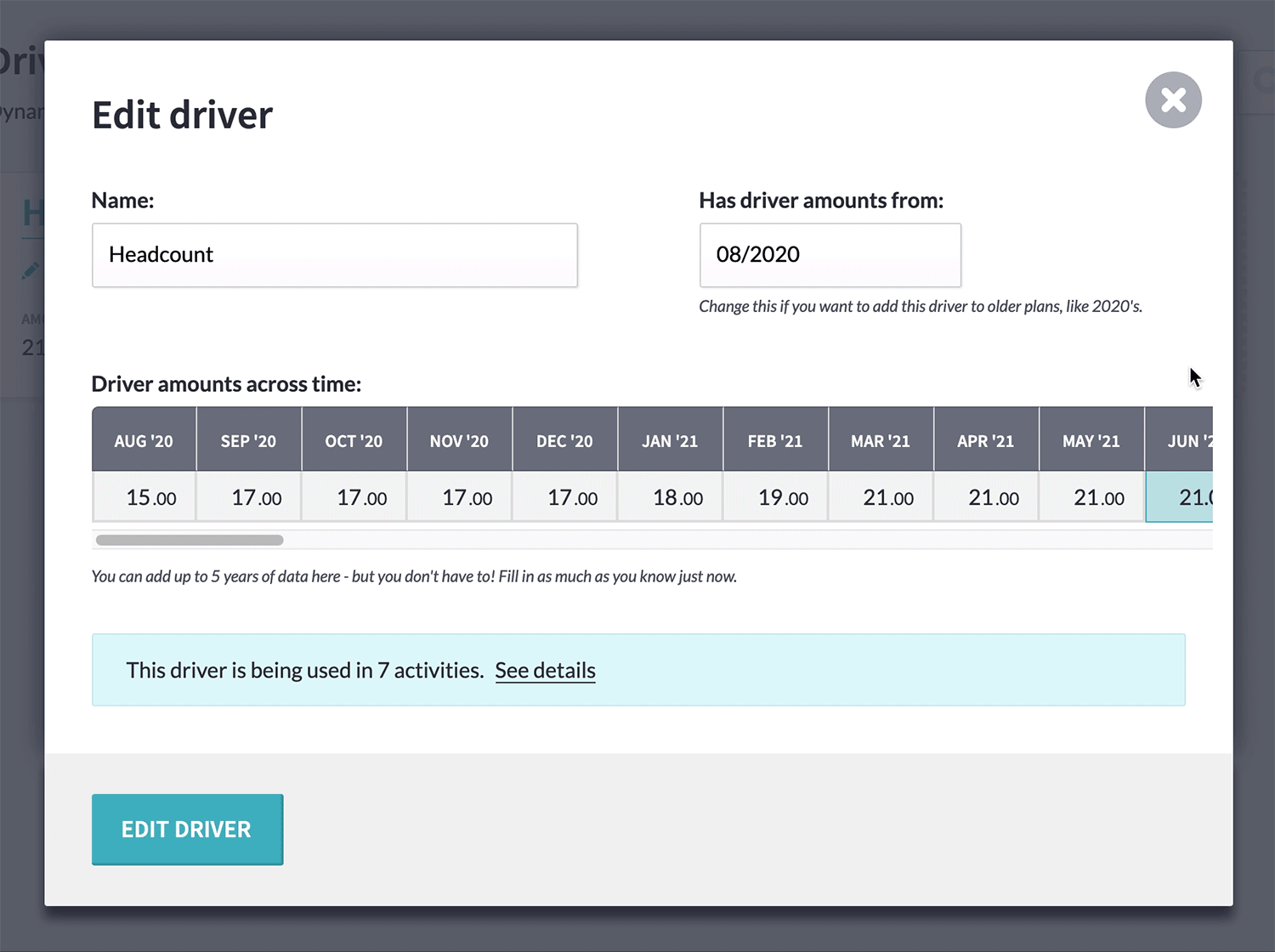
And the historical data won’t be changed. A driver can have up to five years’ worth of figures, broken down into monthly amounts, allowing you to keep your current and upcoming budgets up-to-date without affecting last year’s budgets.
Drivers are created and managed on the new ‘drivers’ page under ‘settings’. Try setting one up now.
Using drivers in activities
Power users and managers can add drivers into activity allocations or forecasts by clicking the ‘add drivers’ button on an activity’s monthly breakdown.
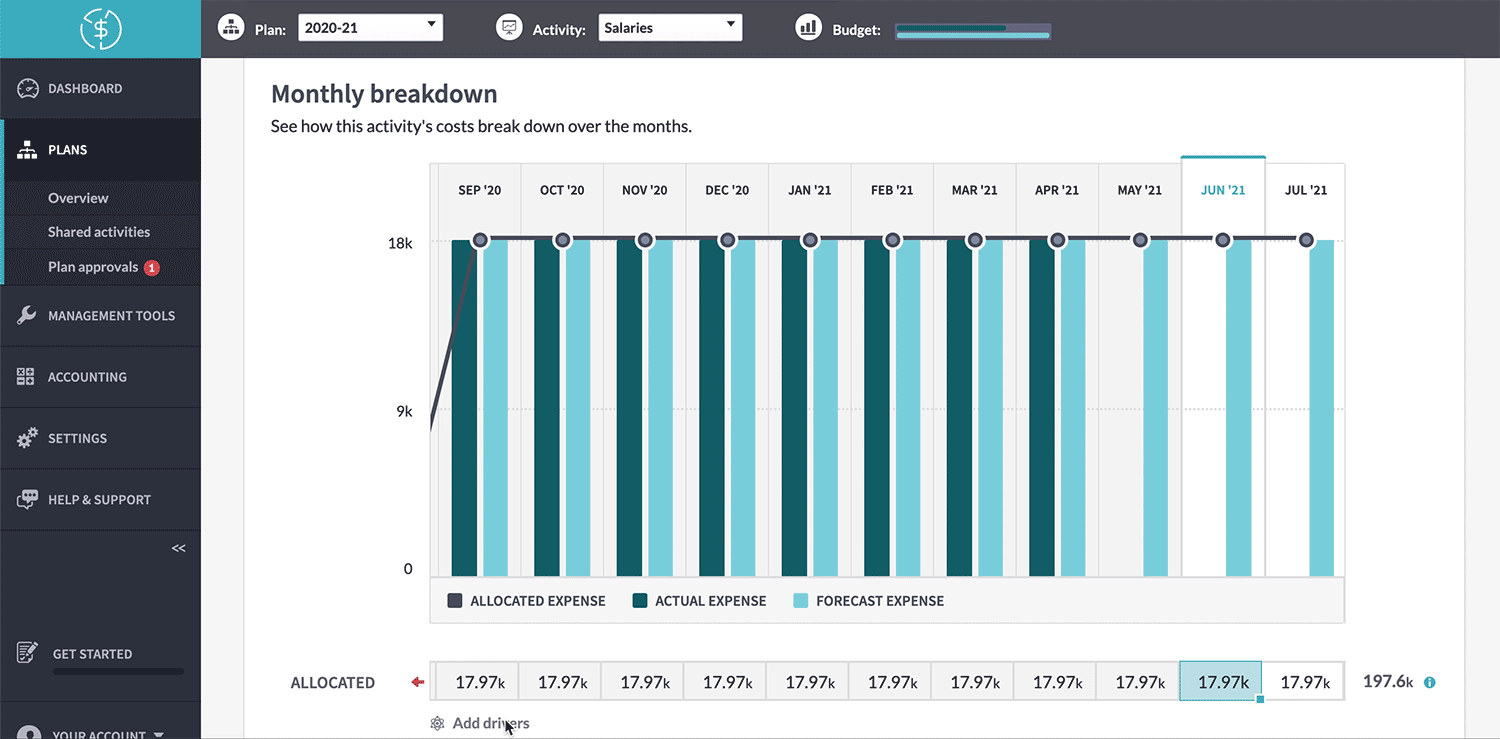
This will bring up a window where you can build a formula using drivers. That might be something like 100 x head count – where 100 is a per-person cost – or 1 x dollar conversion – where 1 is 1 GBP being converted to USD.
You can also build more complex formulas by adding, multiplying, dividing, or subtracting driver values.
Once you’ve created your formula, it will be applied to every month in your activity.

Similar to how adding a forecast row changes the breakdown, showing a total and then each individual forecast row, adding drivers will change the ‘allocated’ or ‘forecast’ row to an uneditable summary. The detail will be in two new rows underneath it – ‘driver’, showing the driver amount per month, and ‘manual’, which will let you add in extra figures, outside the driver.
If you want to remove a driver from a month or change its formula, you can click into an individual month to make changes, and drag those changes across the surrounding months.
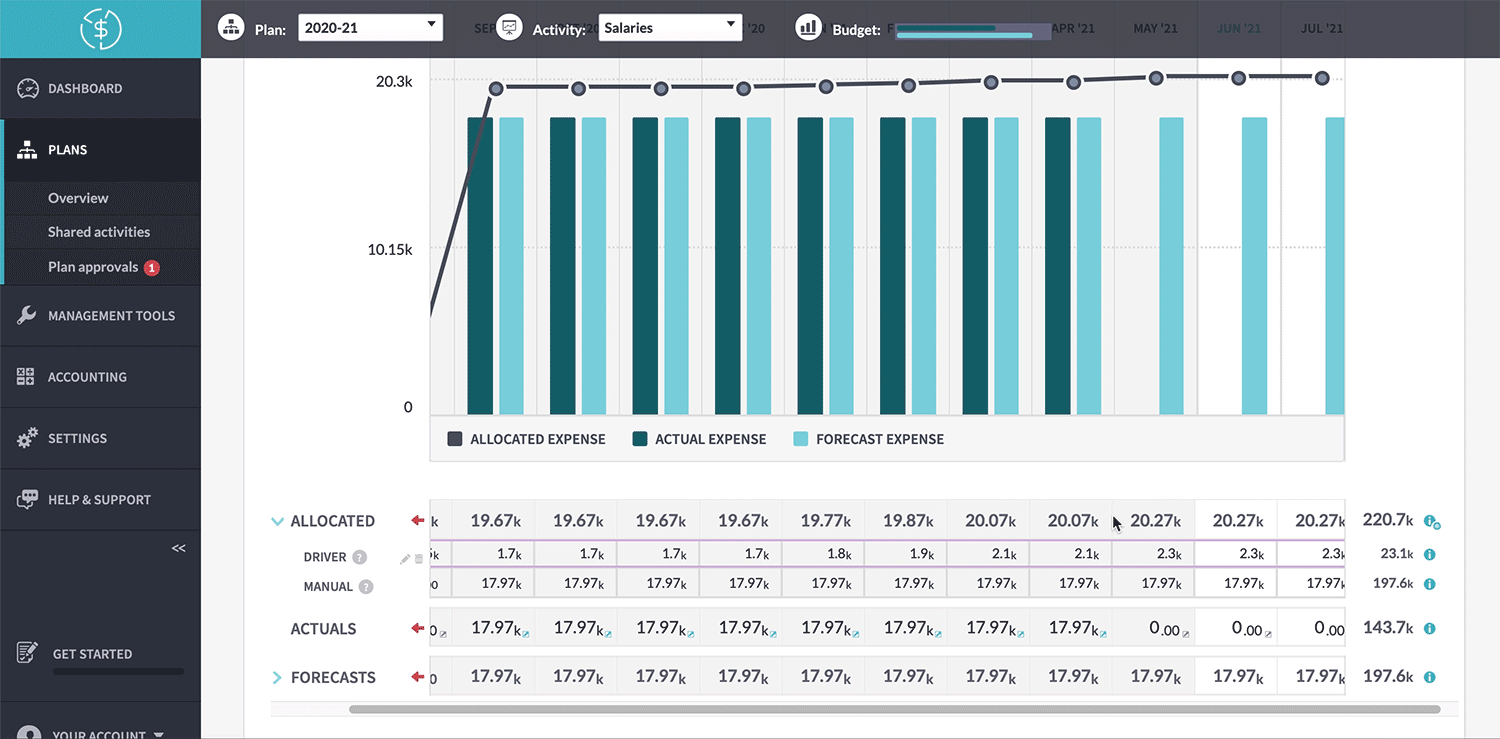
We’ll always hide the details when you go onto an activity page (save you scrolling!) but you can click on the blue arrow on the left or anywhere on the summary row to see the full breakdown.
Try adding drivers to your budgets now and bring your planning to the next level!
The post Feature spotlight: drivers appeared first on Beyond.
]]>The post Feature spotlight: copying a plan appeared first on Beyond.
]]>On Beyond, you can create a plan for your new financial year in two clicks, by basing it on your current plan.
First, click into your current plan and select ‘copy this plan’ from the menu.
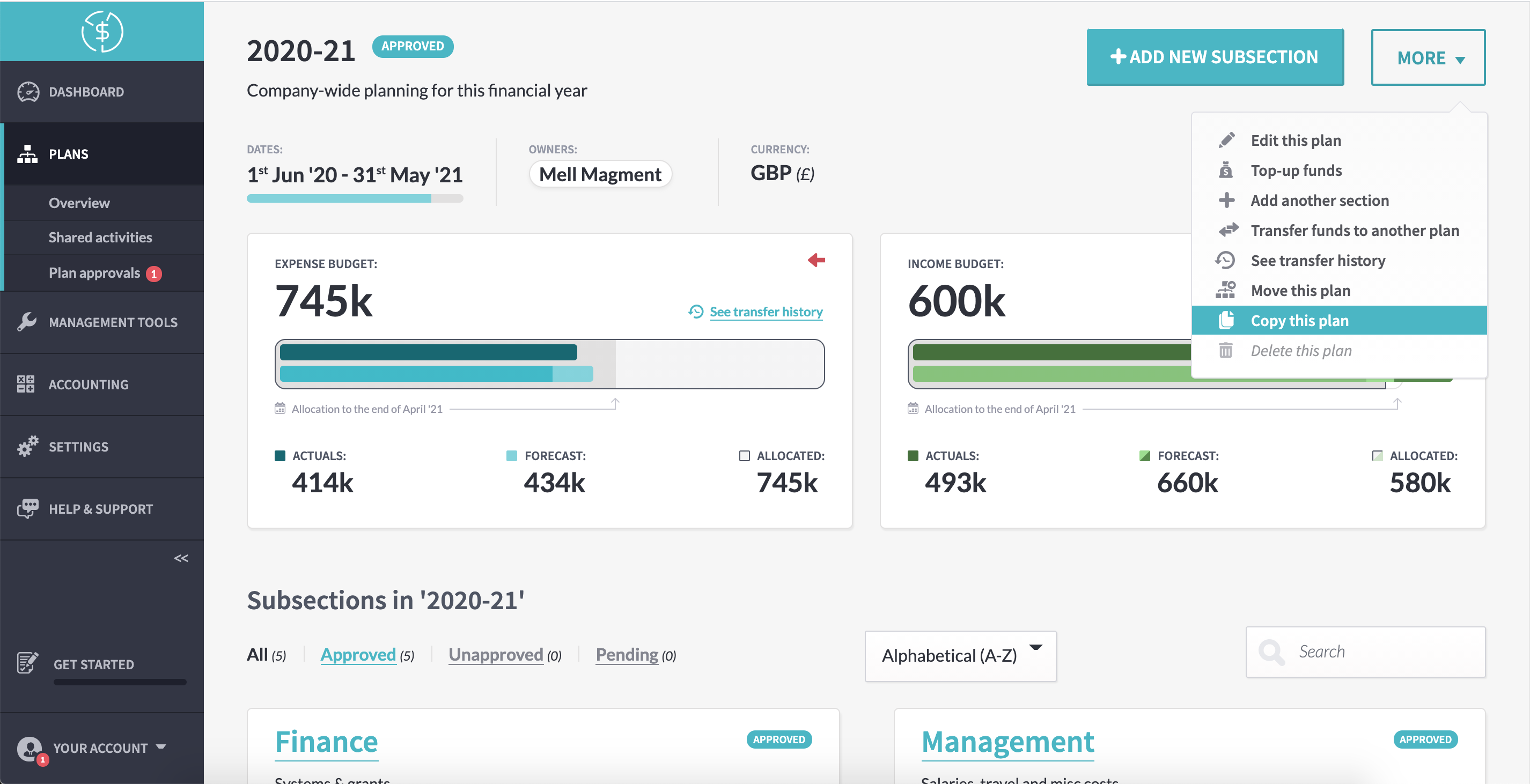
This will bring up a form where you can pick a plan name, an end date, and choose whether the plan budget is already approved.
If you want everyone who’s contributing to the plan to submit their budgets to you for approval, leave this on ‘no’. This is useful if you plan with bottom-up budgeting – if you don’t have exact numbers planned out for each department and you want them to put together a plan of what they’ll need for you to sign off on. (Just remember, your plan will only be reachable from the ‘unapproved’ tab until you’ve approved everyone’s budget!)
If you’re giving everyone a set amount and leaving them to sweat the details, tick ‘yes’. If you’re planning with top-down budgeting, this will save you some time!

And – that’s it! Once you hit the ‘copy this plan’ button, a new zero-based* plan will be created, modelled on the same structure.
The details – like budgets, forecasts, and – of course! – actuals won’t be carried across, but the structure of the plan will. Your new plan will be broken down into the same departments, teams, and budget owners. Though you’re free to edit and delete as you need, without affecting the original plan.
Best of all, the activities in the original plan will be extended into the new plan; this means ongoing expenses, like rent and utility bills, will already be accounted for. Any changes made to them inside the new plan won’t affect their numbers inside the original, but the two will be linked together; your team can quickly switch between financial years to compare and track numbers.
And any automatic rules you’ve set up on your activities will keep running – you don’t need to set them all up again!
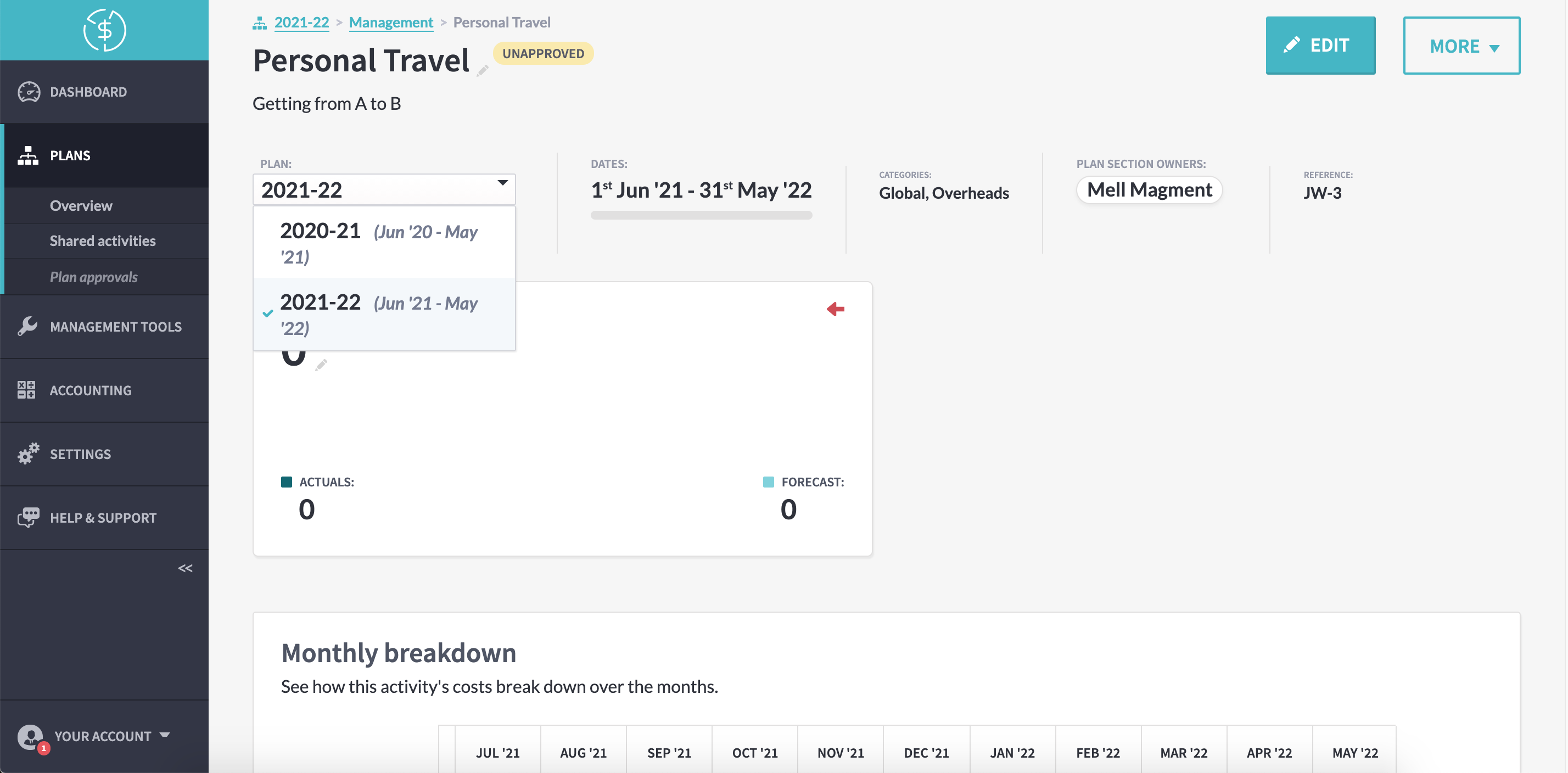
All that’s left is to go through the new plan, adding the new budgets and making whatever changes you need to. You can delete plan sections and activities without affecting the original plan – while being able to quickly compare long, ongoing projects between them.
(Though keep your eyes peeled – we’ll be adding incremental budgeting options soon, so you can carry across the numbers you care about and make your new budget even faster!  )
)
The post Feature spotlight: copying a plan appeared first on Beyond.
]]>The post Feature spotlight: breakdown reports appeared first on Beyond.
]]>Get a high-level overview of a plan (or multiple plans) broken down by the details that are most important to you – profit and loss, company structure, or custom categories.
Then delve into the details where you need to, drilling down into departments, teams, and individual contributions to the plan to get a full picture of your budget – and any potential problems.
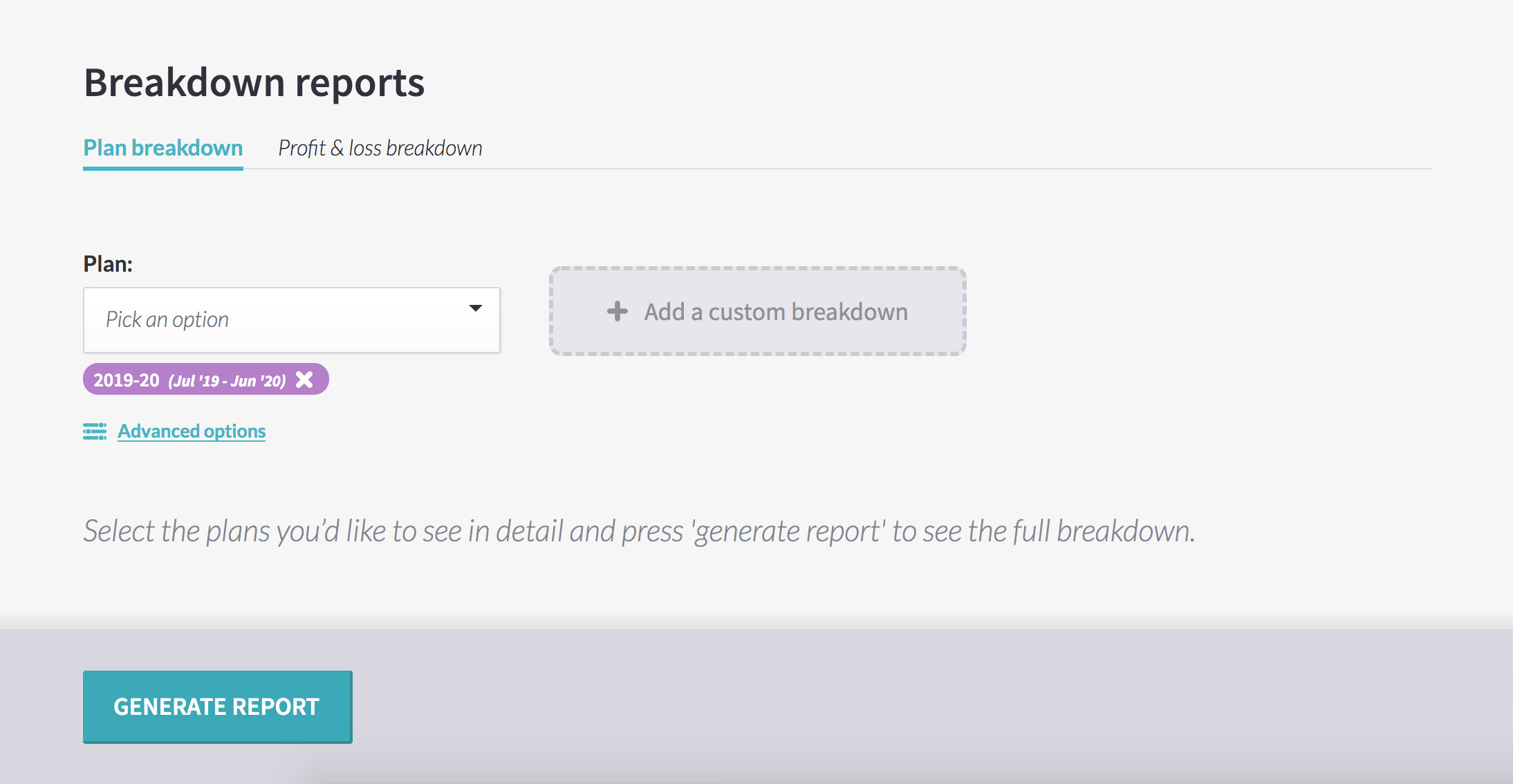
Plan breakdown reports
Available to managers and power users, the breakdown reports page is inside ‘management tools’.
To save you time, the plan your organisation is currently working on – like the 2020 budget – is pre-selected. Hit ‘generate report’ to see the plan, broken down by its first level of subsections.
Click the arrow by any subsection to drill down deeper, seeing that subsection’s subsections or its activities. Or, click the icon beside the section or activity name to jump directly to that part of the plan, to edit or manage it as needed.
When you’re finished, click the back button on your browser or ‘management tools’ in the navigation to return to the report.
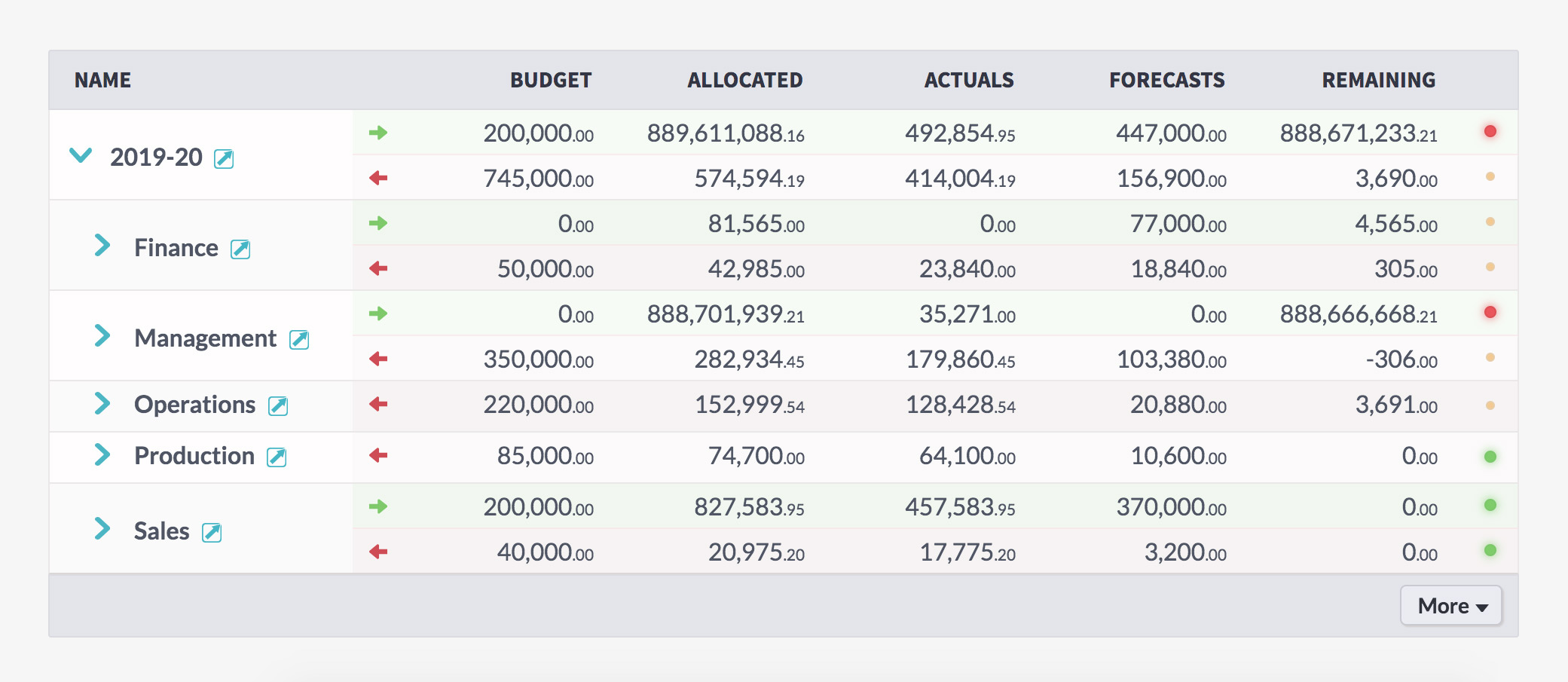
You can see the high-level details on the report itself – budget, allocated, actuals, forecasts, and remaining amount.
You can also see a status indicator for each section of the plan, showing if it’s over or under budget, so you can see which sections need attention.
View the report however it most makes sense to you
The report has toggles for ‘display’, ‘type’, and ‘view’ which you can change to see what’s most relevant for you.
Switch between a number-heavy table layout, to see the nitty-gritty details, or a graph if you prefer to see things more visually.

Focus on just the income or expense, under ‘type’, or click ‘both’ to see a full view of your business.
And click ‘month-by-month’ to see the figures broken into their allocated, actual, and variance figures for each month across the life of the plan, rather than the zoomed-out ‘overview’ of the budget.
And, of course, you can export your data to a .CSV file if you need to take it out of Beyond by clicking the ‘more’ button at the bottom of the report.
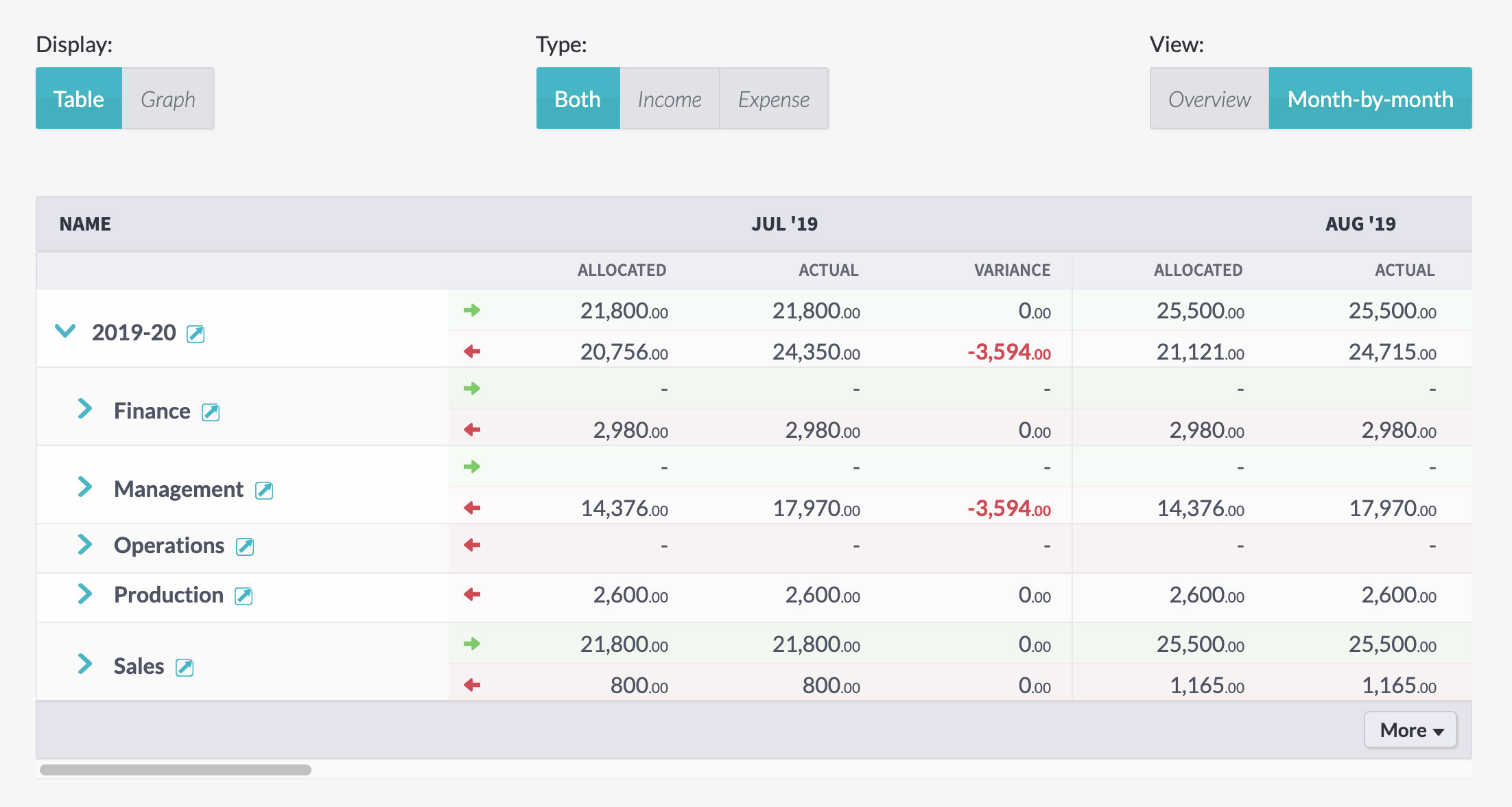
Profit and loss reports
And you can see more than the allocated and actual figures in your report – you can see a full profit and loss breakdown of your plan by clicking the ‘profit & loss breakdown’ tab at the top of the page.
At the top of the screen, you’ll see options for ‘company’ and ‘plan section’, allowing you to look across everything or to delve into particular details.
Hit ‘generate report’ to see how the figures breakdown into turnover, profit, and costs.
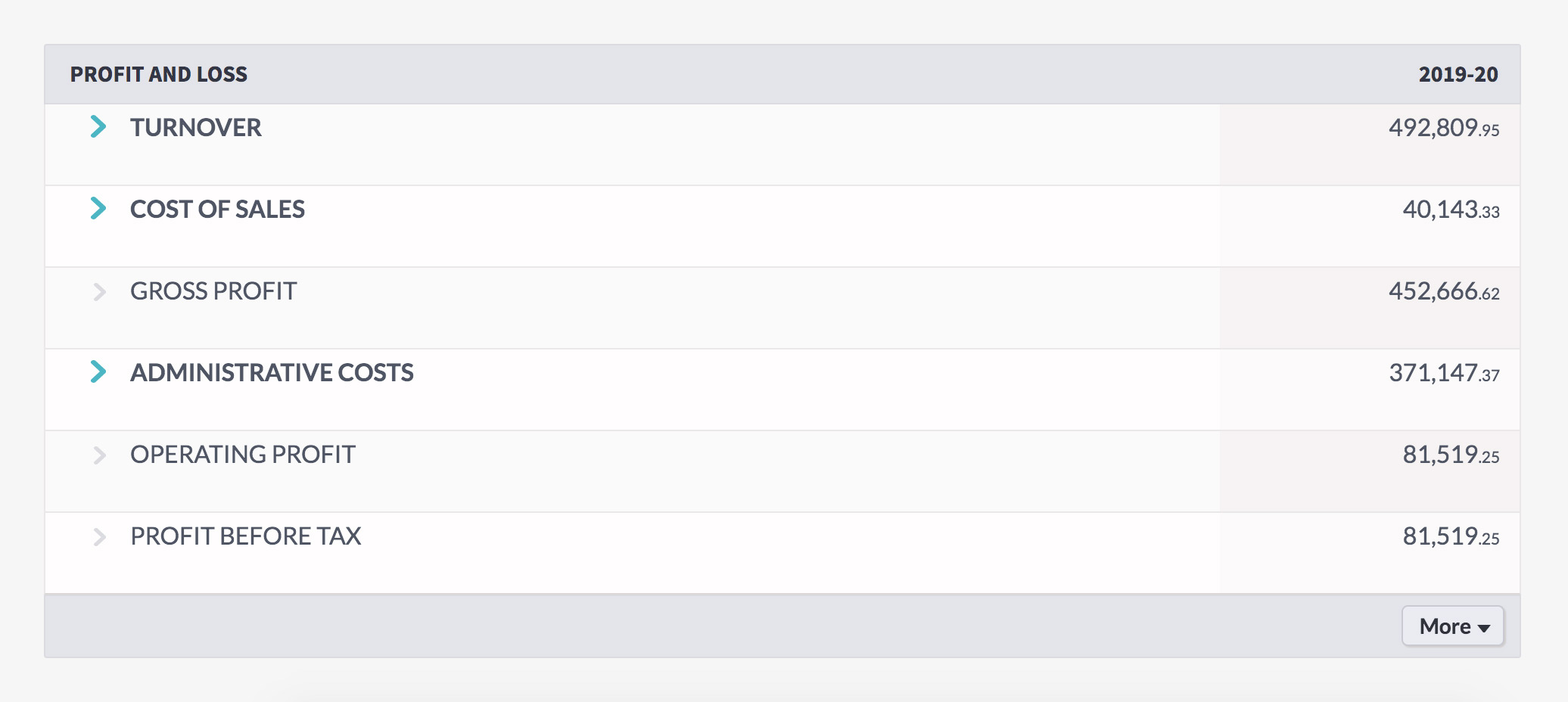
Viewing multiple plans in a single report
You can choose as many current, upcoming, and past plans as you’d like to see from the ‘plan’ dropdown.
Click the cross by a plan’s name to remove it from the report.
By default, the report will be broken down by the top level of each plan, showing each plan in separate sections.
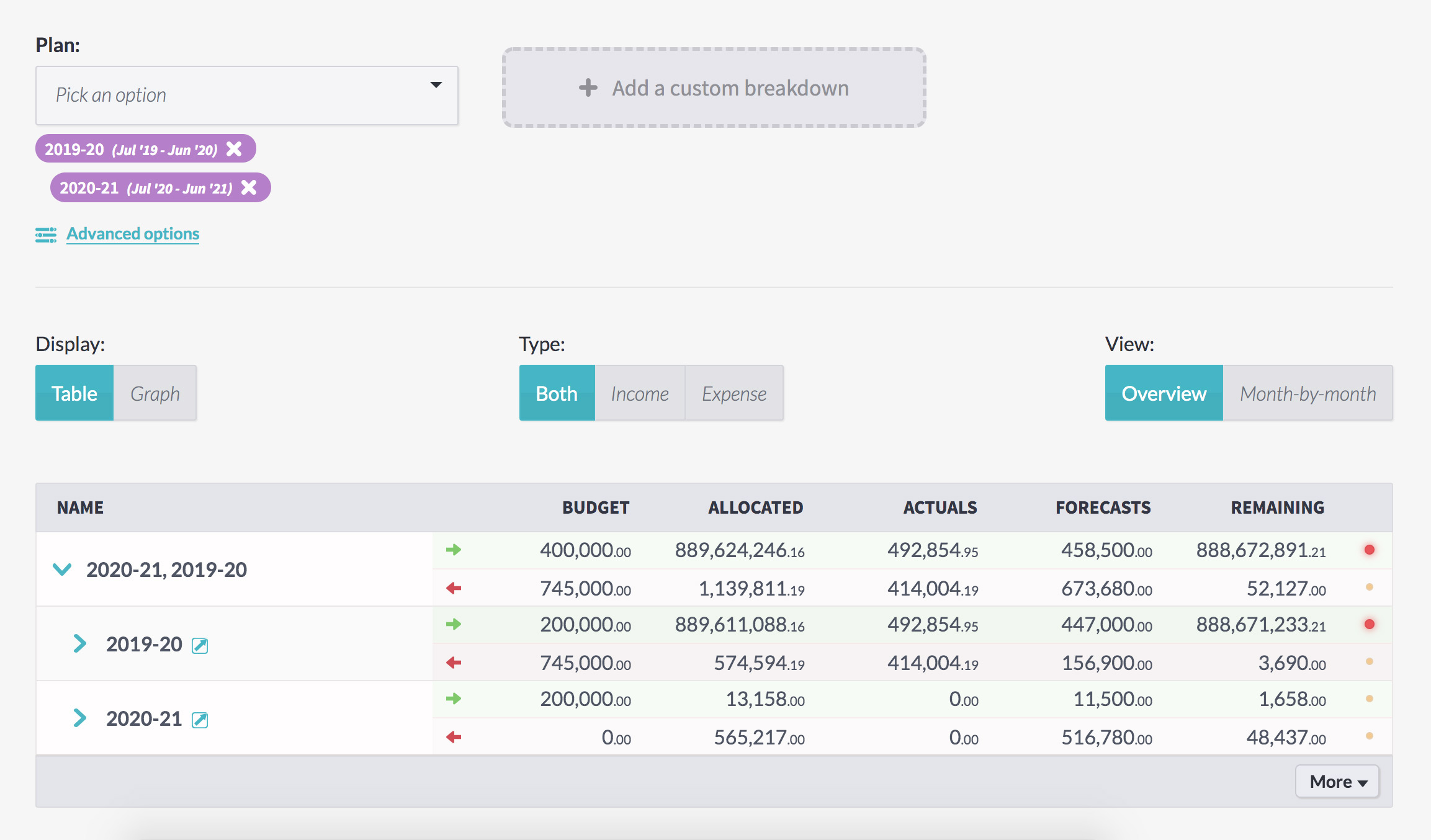
You can compare plans more closely by choosing a custom breakdown.
Custom report breakdowns
You can split the report by different sections and values by choosing a custom breakdown.
Click the ‘add a custom breakdown’ box next to the plan dropdown field to see the breakdown options. You can choose a different plan section level or an activity category.
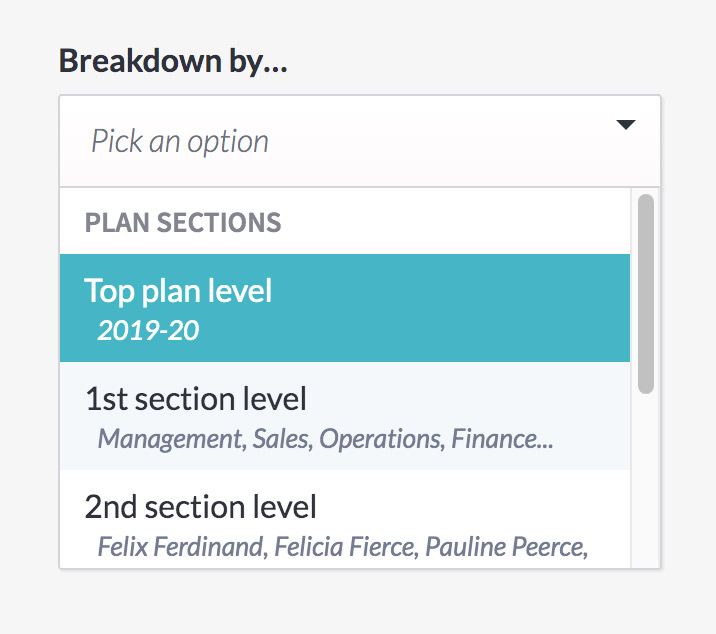
Breaking reports down by plan section level
Plan section levels are all the plan subsections at that level of their plan.
For example, here, the 2019-2020 plan is broken into five subsections. These are at the first level.

Each of those subsections either have their own subsections – the second level – or have activities.
If you wanted to see a report on two different plans, starting from their second level, the report would begin with the subsections of the subsections directly inside the parent plan.
You’d still be able to see this detail starting from higher up, though you’d need to drill into each subsection.
Looking across multiple plans, any plan subsections which share a name on the same level will be merged together, so you can track plans across different financial years or merge plans budgeted in different currencies.
Breaking reports down by activity category
Activity categories are a way to structure and organise activities across your company in whichever way makes the most sense to you.
For example, a multinational business might want a ‘location’ category, with options for ‘Asia’, ‘North America’, and ‘Europe’. Users would be asked to choose which location their activity belongs to when they make one.
With activities structured and organised this way, we can easily breakdown reports by location. (Or by initiative, department, function, client, favourite colour…)
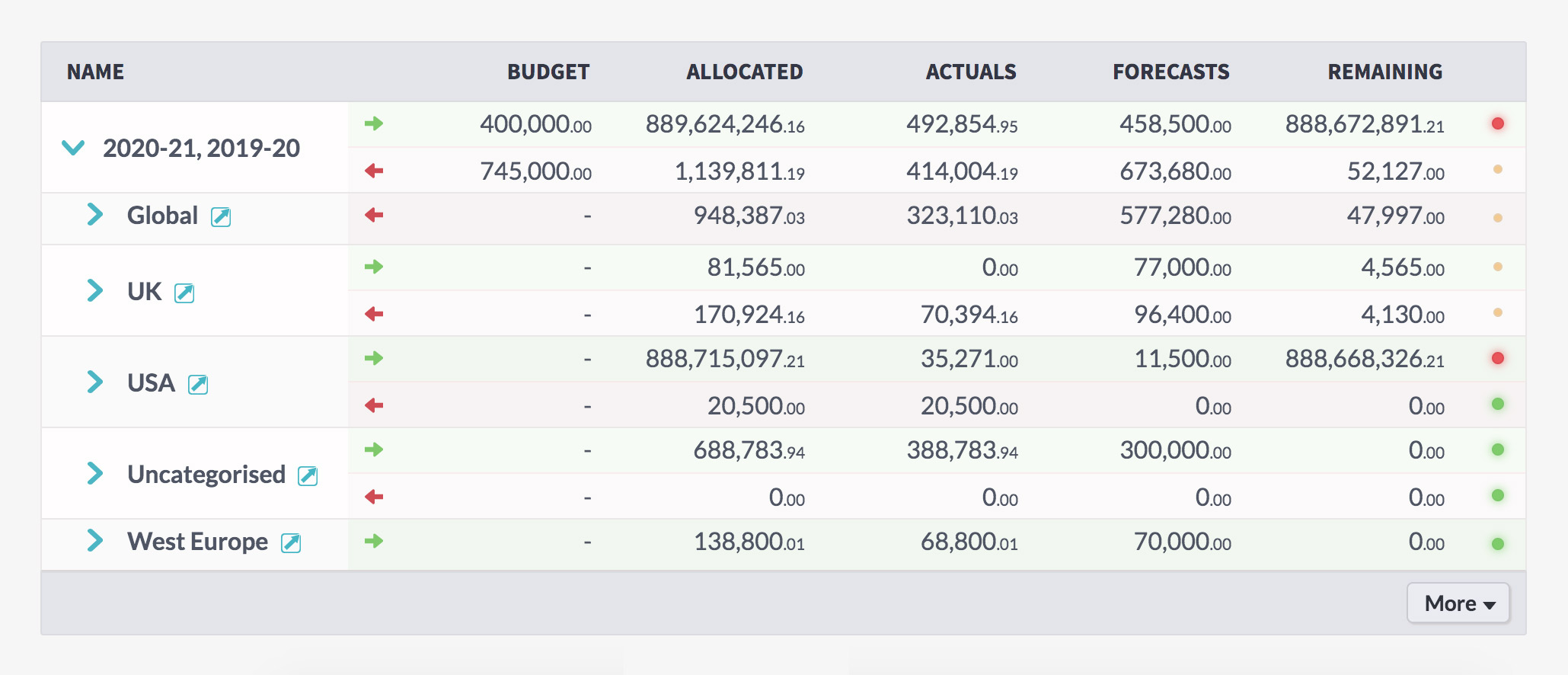
Once your activity categories have been set up by power users on the ‘settings’ page, you’ll see an ‘activity categories’ section at the bottom of the breakdown dropdown field.
Select a category to see the report broken down by that category’s options.

Creating a detailed breakdown
You can go as in-depth as you’d like to, selecting multiple section levels and multiple activity categories by pressing the ‘add another breakdown’ button.
And you can tweak and re-run the report as you need, to get a full picture of what’s happening. Breakdown the financial year by department first and location second – then run a new report, breaking down by location first, department second, to get a full, 360 picture of exactly what’s happening across your organisation.
Compare plans in different currencies
But seeing multiple plans on the same report goes deeper than keeping everything on one screen – if you have plans in different currencies, for a multinational business, you can convert them into the same currency to easily compare how different parts of the business are running.
Click ‘advanced options’ at the bottom of the report form to see a currency conversion rate for every plan you’ve chosen. You can manually set this to whatever you need, for complete control over how the numbers in the plan will be presented.
Setting the rate to ‘1’ won’t change anything. ‘2’ will double the amount. ‘0.75’ will reduce the figures by 25%.
This is also handy for running reports for your plans in a different currency. If you need to show American investors how their dollars are working, changing the rate to the conversion amount, like 1.24, will convert a GBP plan into USD.
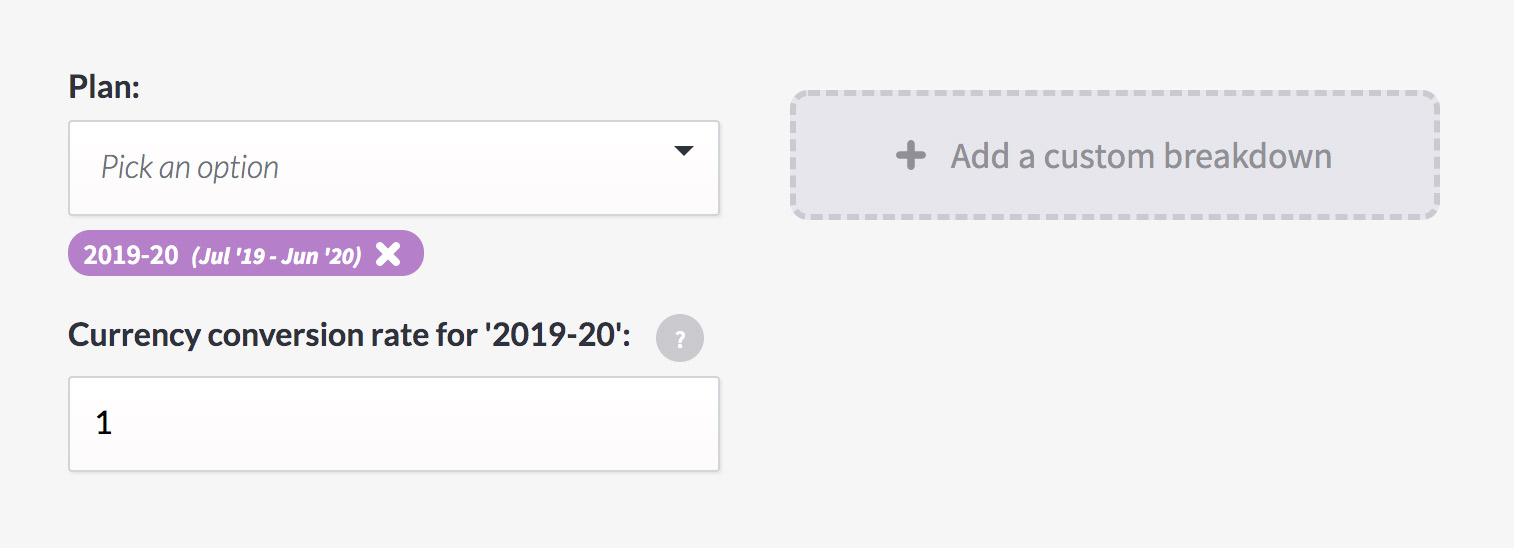
See what’s really happening in your business
Run a breakdown report now to see what’s really happening in your business.
And, if you have any ideas or suggestions for other management tools you’d like to see, let us know! We’re here to make budgeting easier for you. (Yes, you specifically.)
The post Feature spotlight: breakdown reports appeared first on Beyond.
]]>The post Feature spotlight: automatic rules appeared first on Beyond.
]]>Rules automatically assign new transactions to the right activities and plans, and save you time.
Over 99% of the actuals a typical company brings into Beyond are assigned automatically by actuals, without staff needing to review them – that’s hundreds of hours freed up for more important work.
Spend two minutes setting up a rule and save hours of your time for the work you want to focus on. (Or tea breaks. We won’t judge.)
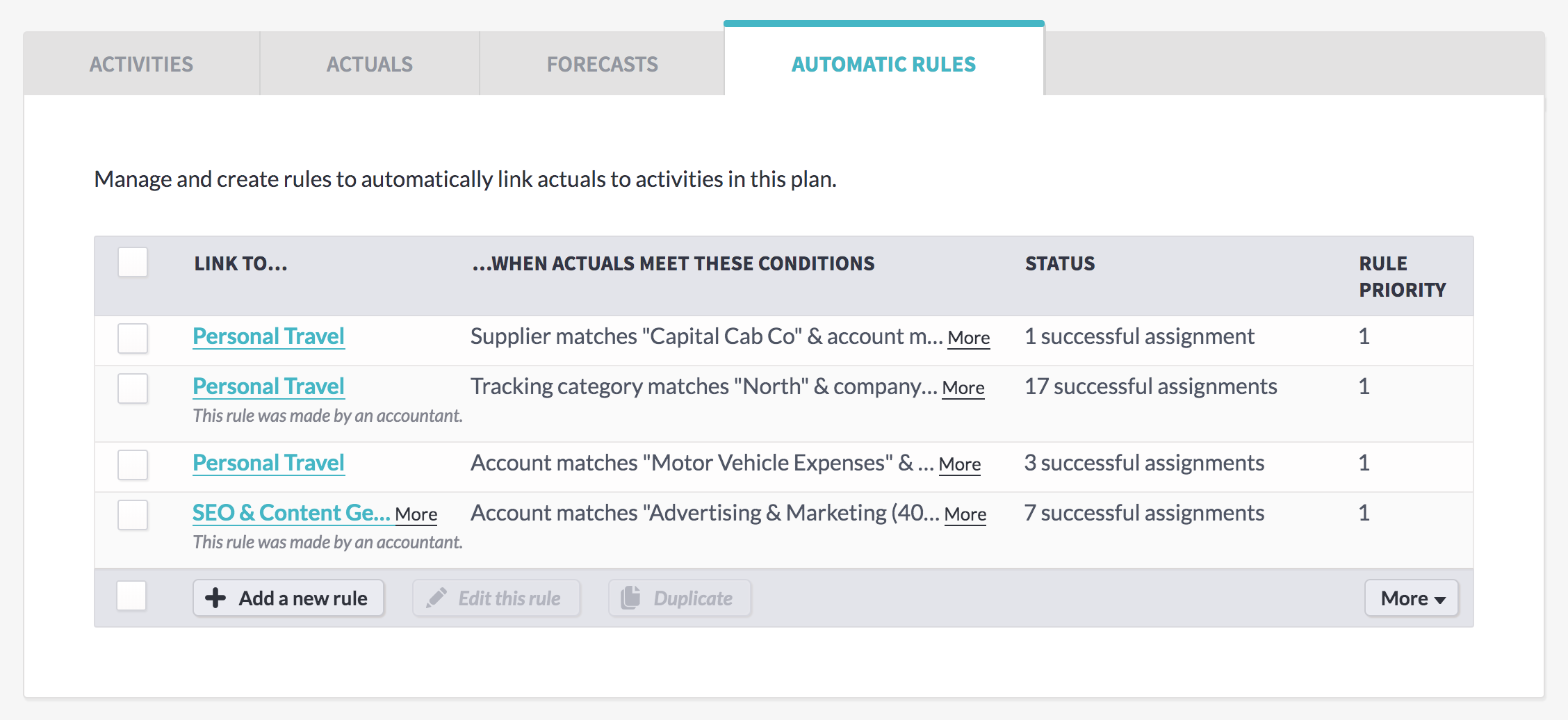
Rules on Beyond
There are two types of rule:
Accounting rules affect every new transaction that comes in from your accounting software. They can only be made by accountant power users, and they can be used to assign actuals anywhere in the business.
Plan rules affect new transactions that come into a particular plan, and can be set up by that plan’s owners to assign actuals to activities inside that plan.
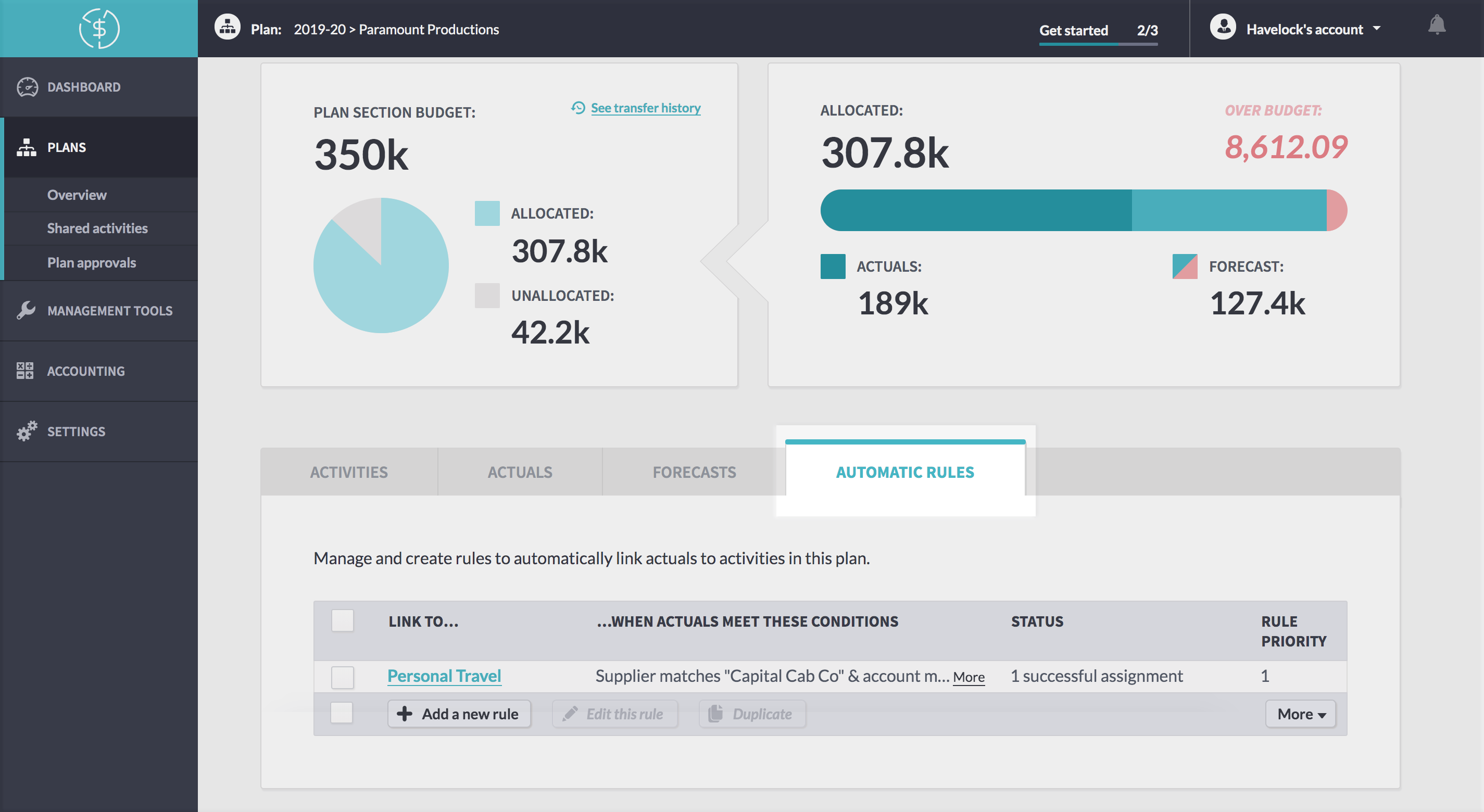
The rules can be used together. For example, an accountant might set up rules to assign everything from the marketing account code to the marketing section of the current plan budget.
But different actuals will belong in different activities that the accountant can’t know the ins and outs of – so the marketing team can create rules based on the supplier and the description to automatically put the right actuals into the right activities.
The budget stays up-to-date – and everyone can focus on more important work.
Creating a new rule
Making a new rule is kuh-wick, with a K.
Step 1
First, open the ‘automatic rules’ page in the accounting section, or go into an individual plan and click on the ‘automatic rules’ tab.
Step 2
Click the ‘new rule’ button and tell us where you’d like actuals to be moved to when they meet the right conditions.
You can link directly to an activity if you know it, choosing from a list across the business. Just start typing to filter the list – it’s going to be big!
Or, if you don’t know exactly where it’s going, link it to the plan for the plan owner to move later.
You can also park actuals which shouldn’t sit inside any plans, if you need to.
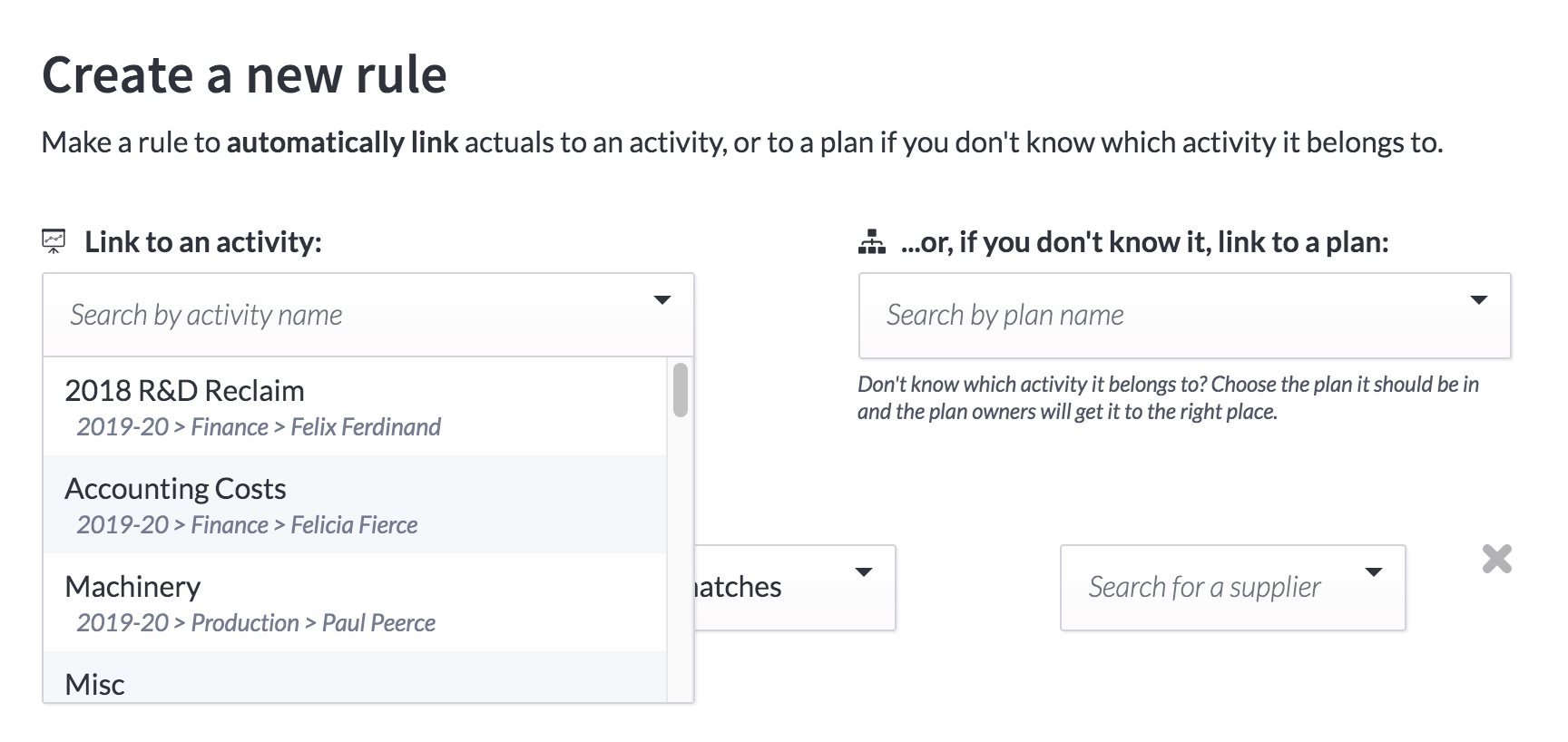
Step 3
Next, tell us what conditions an actual needs to meet to follow this rule.
You can use any data that will come in from your accounting system – the supplier, the account name or code, what type of actual it is (like a pre-payment or an invoice), the description, the reference, the company it comes from, or the tracking category.
And you can be as precise as you want to be. If you’re matching on the supplier, it makes sense to choose an exact supplier name from the given list. If you’re matching on a description, you probably only care that it contains a certain word or phrase. Or maybe all the account codes for a certain plan will start with the same two numbers.
You can add as many conditions as you need to perfectly match the actuals you’re expecting. A rule will only be applied if it meets all the conditions, so it often helps to be more specific.

Step 4
Hit the ‘create new rule’ button and make yourself a cuppa. You’ve just freed up your schedule!
Or create a rule in context
Good news for accountants: you can create a new rule even quicker than that!
Hit the ‘make a rule’ button when you’re assigning an actual to create a new rule based on that actual’s metadata. Any other actuals with the same details – like the company, account name, and supplier – will be assigned to the same plan or activity.
Or you can tweak the conditions before you hit ‘assign’, taking some out to make a broader reaching rule, or adding more in for a more specific rule.
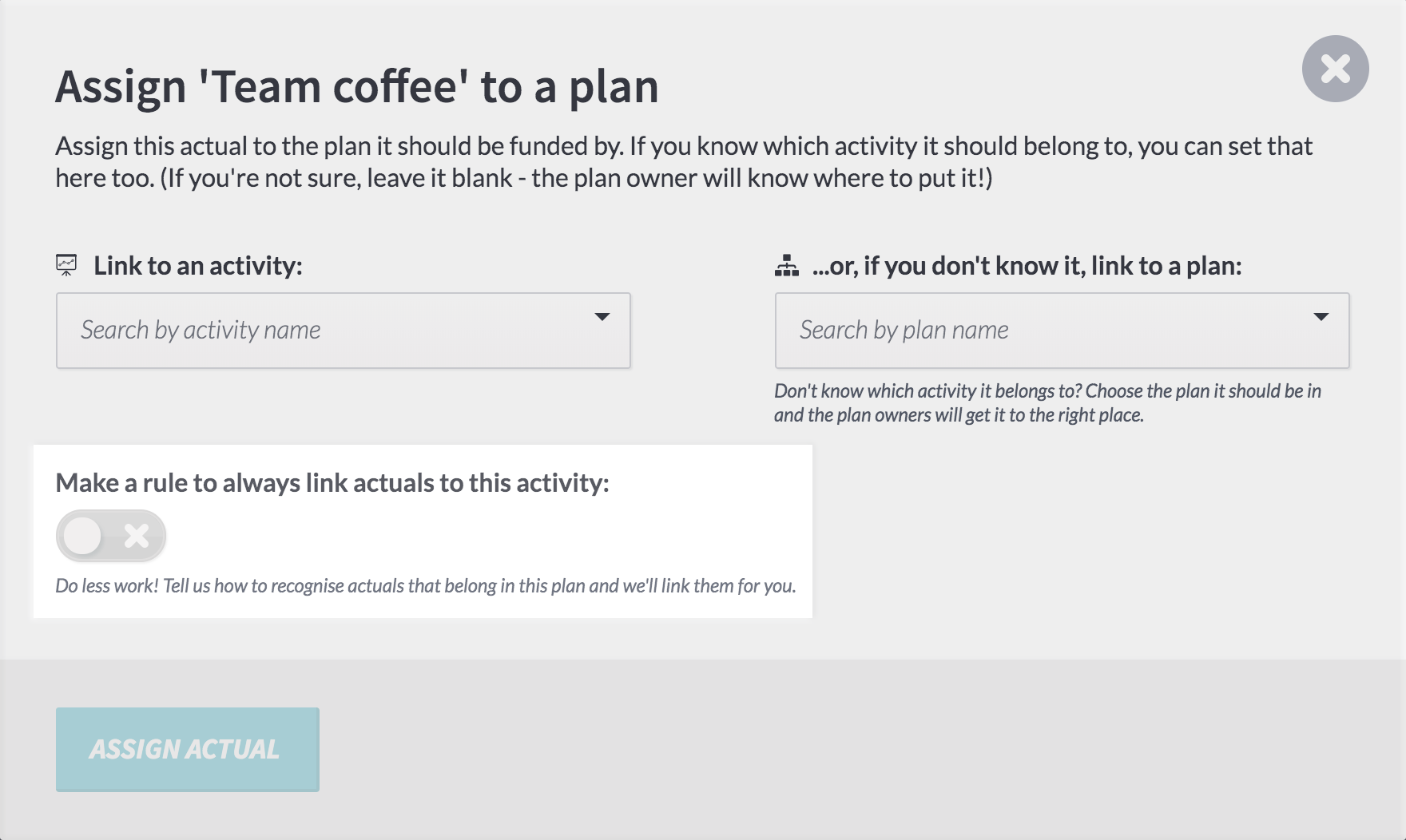
Priorities, priorities
An actual can only be affected by one rule. After all, it can’t sit in two different budgets.
But sometimes more than one rule could apply to an actual. Maybe its supplier is Advertizely – which would go into the marketing plan – but its description starts with ‘concepts’, which would usually go into the R&D plan.
Setting a priority on your rule lets you determine what should take prominence.
By default, rules are set to 1, but higher numbers have a higher priority.
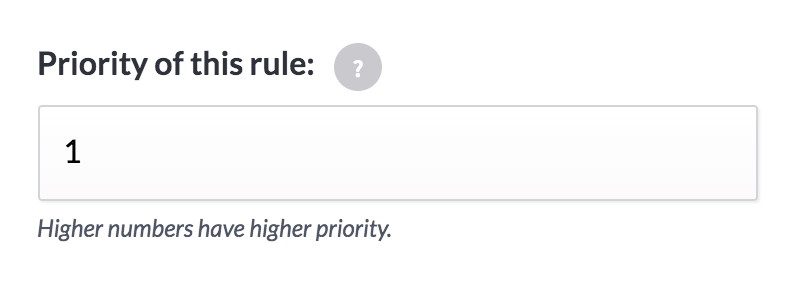
If all costs from Advertizely should be assigned to marketing, setting the priority as 100 would make sure it always takes precedence.
If rules clash that have the same priority – if both were 100 say – then the rule which has the most conditions will take prominence.
What’s the status?
All the rules that have been created across accounting or across a particular plan will show in a table.
You’ll be able to see where they’re linking to, what their conditions are, their priority, and their status.
Status is how many times that rule has successfully assigned an actual to the right place. Hopefully that’s all the time, but plan owners have a ‘not for this plan’ button they can press if an actual has come to them that shouldn’t.
If a rule is too broad, it might send actuals to the wrong place, so this number is useful to keep an eye on. Keep watch to see if your rule needs to be tweaked to take other things into consideration.

You can edit a rule by clicking the ‘edit’ button on the table, and all future transactions will be affected by the new, improved rule.
Work smarter
Rules are all about working smarter. (And drinking more tea.)
If there are small differences between actuals that would put them in different activities – say transactions from the same supplier, Advertizely, should always be in marketing but ones with a particular account code should be in a particular activity – you can use one rule as a jumping off point for another.
Rather than repeating all the conditions you’ve entered before, you can choose a rule and click the ‘duplicate’ button, using it as a starting off point rather than making a new rule from scratch.

(Don’t worry – Beyond will always tell you if the rule you’re making already exists and what kind of impact it’s likely to have, so you can make the rules that work best for you.)
Rules rule
Start making rules to automate your work and free up your time now. Right now!
The post Feature spotlight: automatic rules appeared first on Beyond.
]]>The post COVID-19 has thrown us all off track. <br/>Let’s get you back on. appeared first on Beyond.
]]>
Beyond exists to help businesses navigate change, to enable them to make the most effective use of their resources and to keep employees in the loop no matter where they are.
Right now, being able to do these things fast and well is more crucial than ever.
We’ve been thinking how we can help as many businesses as possible work through the challenges and upheaval caused by COVID-19.
So we’ve decided to give all new accounts free, unlimited access to the full Beyond platform until the 1st of August, 2020.
There are no catches and no obligations. You don’t even need credit card details.
If you need a platform to help plan, track, and manage your financial changes, or are making the most of a quieter period of business to improve your processes, we want to help.
Sign up now at headbeyond.com – no strings attached.
Update from Beyond HQ
I’m happy to report that first and foremost the Beyond team is safe and well. As a part-remote team already we have adapted fairly easily to this brave new world – we are ready to support our clients through their own challenges.
In related news, we’re also fast-tracking a suite of new features we’ve been working on to help at this turbulent time. Scenario planning, driver-based forecasting and a host of other functionality will be making their way to Beyond very soon. Watch this space.
Keep safe, and keep washing those hands!
The post COVID-19 has thrown us all off track. <br/>Let’s get you back on. appeared first on Beyond.
]]>The post Activity Categories: new dimensions of budgeting appeared first on Beyond.
]]>Being able to answer these questions in real-time already places you many steps ahead of most businesses, but we can do even better.

How about being able to answer these questions?
- What’s my monthly spend on travel and how does it compare to other categories?
- How do my revenue and costs compare across locations?
- How much per year is going towards business-as-usual versus strategic work?
- What is the budget variance for my key programmes across the business?
These questions, and many more, can now be answered with the powerful new view added to the Budget Explorer:

And this view is just the start – from here you can click into any category and drill down to the underlying activities, actuals and forecasts that drive it. Very cool.
These views are made possible by the use of ‘Activity Categories’. They’re extremely flexible – think of any category or dimension you’d like to tag activities with (like Location, Programme, Type, Client, Goal…) and list the different values this category can take. Then whenever any user creates an activity, they’ll be able to choose which category value to tag that activity with.

In only a few clicks, you can ensure every relevant activity is tagged by the categories that make sense to you. Tracking budgets and managing activities across the business just got a whole lot easier.
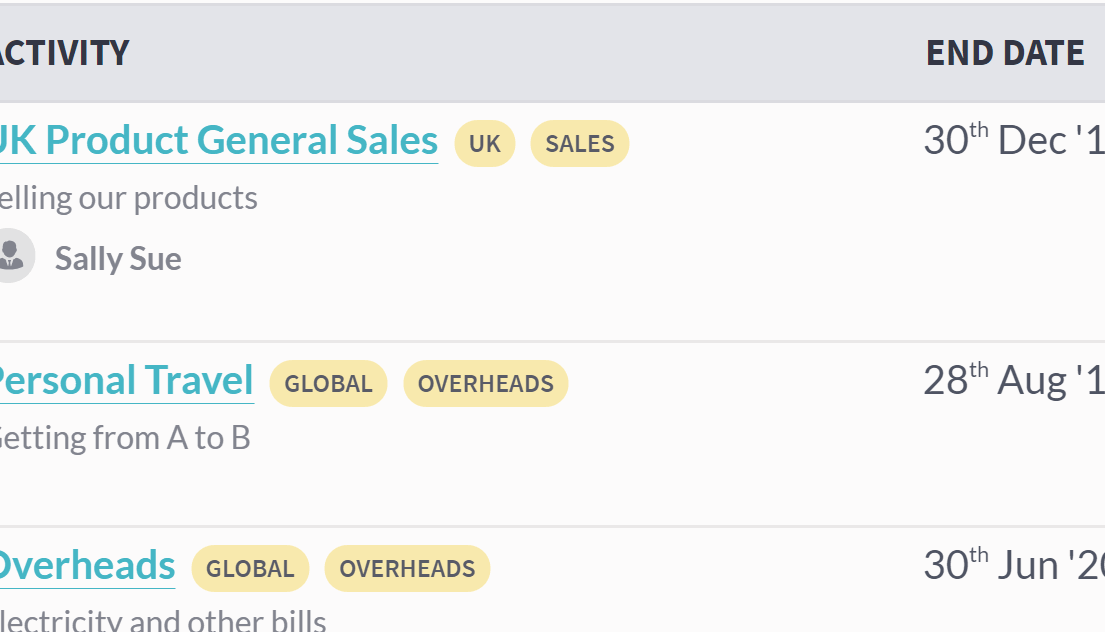
Happy tagging!
Of course, the Budget Explorer view and the underlying Activity Categories are both completely customisable, so you can slice, dice, breakdown and summarise based on your precise business needs (and update them as they change).
With Beyond, you’re always in control.
The post Activity Categories: new dimensions of budgeting appeared first on Beyond.
]]>The post Introducing the dashboard: everything you need to know appeared first on Beyond.
]]>
…what do you mean you asked for a pony?!
Now, as soon as you log in, you’ll see a summary of the most important things you need to know – with anything you need to take action on or worry about highlighted, so you can’t miss it.
We think it’s a fantastic tool that will help save your time and draw your attention where it’s needed. (Though we are, of course, massively biased.)
Let’s dive in and show off show you how it can help make your life easier!
Highlights
Available for all users.
Highlights are the most recent – and most important – things you need to know about.
Similar to notifications, highlights will let you know when you’ve been invited to a plan, been delegated an activity, received new actuals, or been asked to approve budgets.
But they’ll also give you updates from the Beyond team, letting you know when we’ve released (amazing) new features or when we’re planning on making updates to the app that will affect your workflow. (For the better, naturally!)
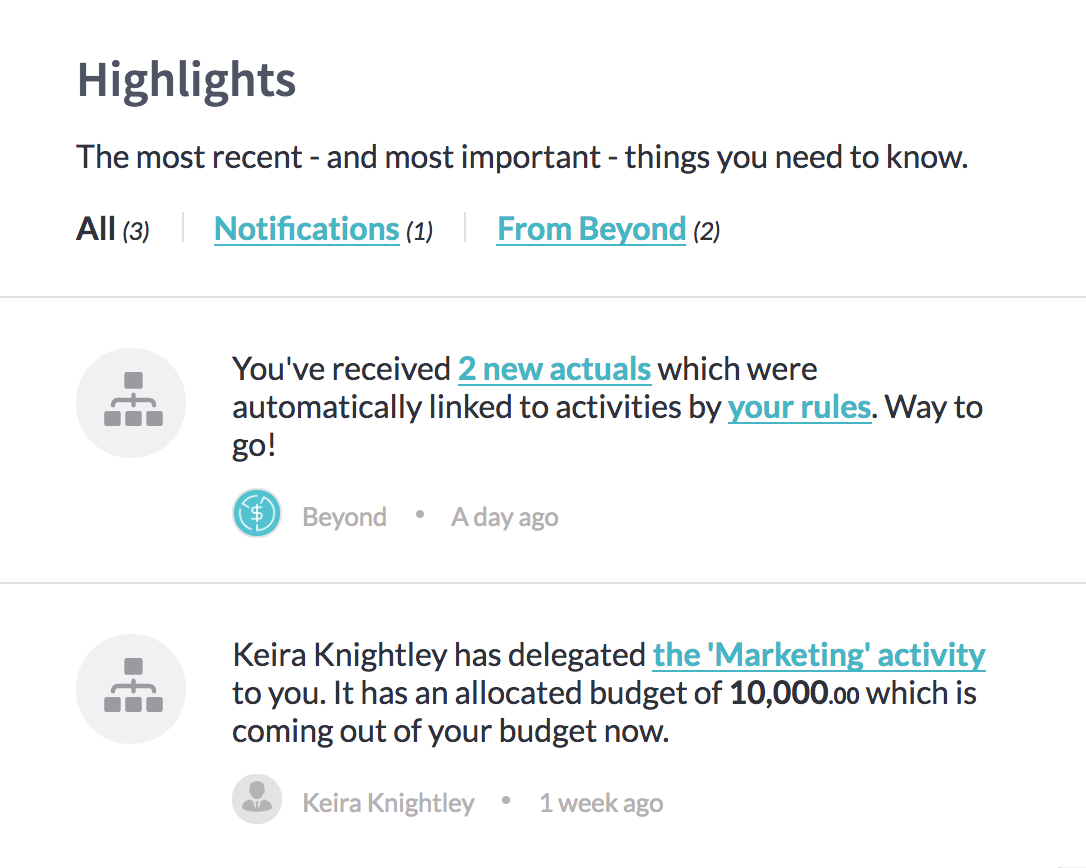
Current plans
Available for all users.
Current plans might be the single most useful feature we’ve added to Beyond. (Shh! Don’t tell Highlights!)
It summarises all your currently running plans, whether they’re for work you’re planning with the whole company or a small project you’re planning alone.

If any plan is overbudget, it highlights the problem right away, making sure you can spot any issues before they become issues.
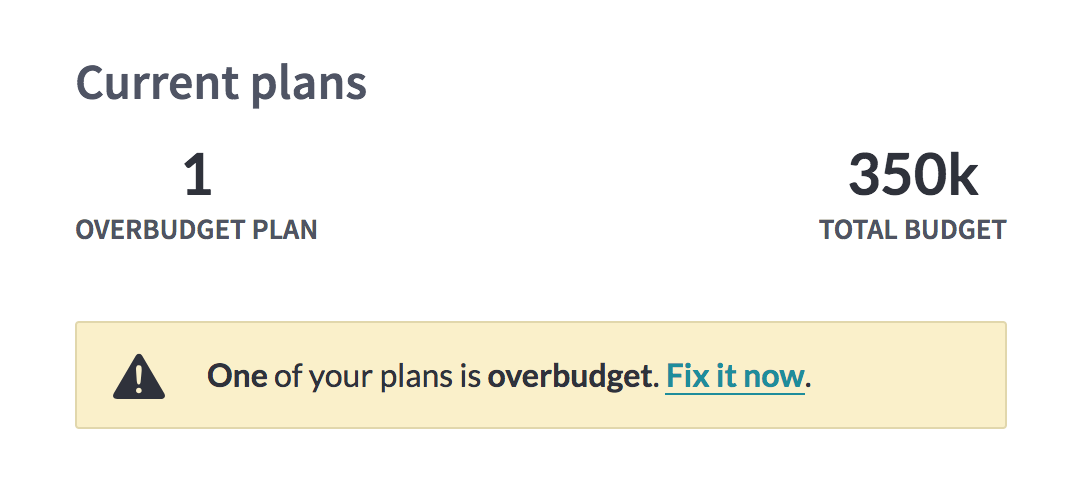
Unassigned actuals
Available for accountants.
When actuals come in from your accounting platform, it’s important to know where they belong and what budget they should be coming out of – or else your numbers might be closer to the red than they look!
The unassigned actuals section will highlight any actuals in the business that haven’t been assigned to a user yet, and help you work out where they belong.

Sync history
Available for accountants.
We know how important it is to keep your plans up-to-date with the latest data from your accounting software. And we know how nervous it can make you, wondering if you definitely have all the facts, before you make a big decision. (Yes, you Ethel. We’ve seen you hit that manual sync button twelve times in a row…)
That’s why we’ve put details about the last sync right on the dashboard page, so you can be assured you’re looking at the most up-to-date data there is.
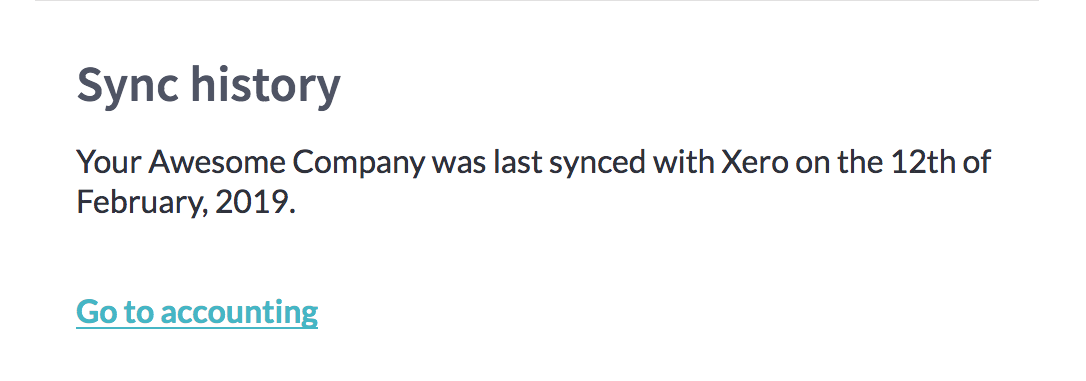
Active users
Available for power users.
To make sure you have a solid grip on how many active accounts you have on Beyond and what price bracket that falls into, we’ve broken the numbers down (it’s sort of what we’re good at, not to brag) into standard users, managers, and power users. You’re welcome!
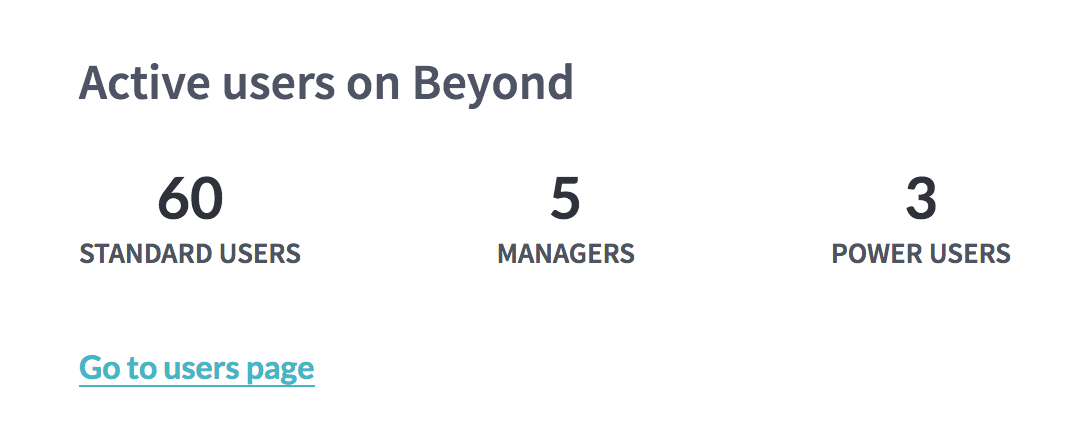
And that’s not all!
We’re planning on adding a lot more features to the dashboard, to make it even more useful for you, like adding the ability to order the dashboard exactly how you like it and to choose exactly what you want to see… And we want to hear what that is!
Let us know what features you’d find useful, what you want to see on the dashboard going forward, and how we can make it even better for you. Email us on support@headbeyond.com with any ideas, complaints, or compliments. We’d love to know how we can make Beyond even better for you!
The post Introducing the dashboard: everything you need to know appeared first on Beyond.
]]>